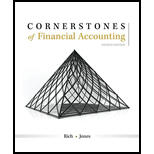
Concept explainers
1.
Concept Introduction:
Straight-line
Depreciation is done by allocating the cost of the fixed assets other than land to expense over the useful life of the asset. The most commonly used method of depreciation is the straight-line method. In this method, every year until the useful life of the asset, an equal amount of assets cost to depreciation expense is allocated.
Disposal of fixed assets:
Fixed assets are disposed of by a company either voluntarily or involuntarily. Voluntary disposal occurs when the useful life of the asset is over or due to technological obsolescence. An involuntary disposal occurs due to damage from fire, theft or natural calamities.
To Prepare:
(b) $7500 cash and (c) $11500 cash.
2.
Concept Introduction:
Disposal of fixed assets:
Fixed assets are disposed of by a company either voluntarily or involuntarily. Voluntary disposal occurs when the useful life of the asset is over or due to technological obsolescence. An involuntary disposal occurs due to damage from fire, theft or natural calamities.
Income Statement:
A company’s income statement shows the revenues, expenses and
To explain:
The reporting of gain or loss on the disposition on the income statement.
Trending nowThis is a popular solution!

Chapter 7 Solutions
Cornerstones of Financial Accounting
- I am trying to find the accurate solution to this general accounting problem with the correct explanation.arrow_forward← Week 1: Homework Question 3 of 4 8.75/10 The project is completed in 2025, and a successful patent is obtained. The R&D costs to complete the project are $113,000. The administrative and legal expenses incurred in obtaining patent number 472-1001-84 in 2025 total $16,000. The patent has an expected useful life of 5 years. Record the costs for 2025 in journal entry form. Also, record patent amortization (full year) in 2025. (Credit account titles are automatically indented when amount is entered. Do not indent manually. If no entry is required, select "No Entry" for the account titles and enter O for the amounts. List all debit entries before credit entries.) Account Titles and Explanation Research and Development Expense Cash (To record research and development costs) Patents Cash (To record legal and administrative costs) Amortization Expense Patents (To record one year's amortization expense) Debit 113000 16000 3200 Credit 113000 16000 3200arrow_forwardJoe transfers land to JH Corporation for 90% of the stock in JH Corporation worth $20,000 plus a note payable to Joe in the amount of $40,000 and the assumption by JH Corporation of a mortgage on the land in the amount of $100,000. The land, which has a basis to Joe of $70,000, is worth $160,000. a. Joe will have a recognized gain on the transfer of $90,000. b. Joe will have a recognized gain on the transfer of $30,000.c. JH Corporation will have a basis in the land transferred by Joe of $70,000. d. JH Corporation will have a basis in the land transferred by Joe of $160,000. e. None of the above.arrow_forward
- Please provide the correct answer to this general accounting problem using accurate calculations.arrow_forwardCan you solve this general accounting question with accurate accounting calculations?arrow_forwardCan you help me solve this general accounting question using valid accounting techniques?arrow_forward
 Financial Accounting: The Impact on Decision Make...AccountingISBN:9781305654174Author:Gary A. Porter, Curtis L. NortonPublisher:Cengage Learning
Financial Accounting: The Impact on Decision Make...AccountingISBN:9781305654174Author:Gary A. Porter, Curtis L. NortonPublisher:Cengage Learning Intermediate Accounting: Reporting And AnalysisAccountingISBN:9781337788281Author:James M. Wahlen, Jefferson P. Jones, Donald PagachPublisher:Cengage Learning
Intermediate Accounting: Reporting And AnalysisAccountingISBN:9781337788281Author:James M. Wahlen, Jefferson P. Jones, Donald PagachPublisher:Cengage Learning Cornerstones of Financial AccountingAccountingISBN:9781337690881Author:Jay Rich, Jeff JonesPublisher:Cengage Learning
Cornerstones of Financial AccountingAccountingISBN:9781337690881Author:Jay Rich, Jeff JonesPublisher:Cengage Learning



